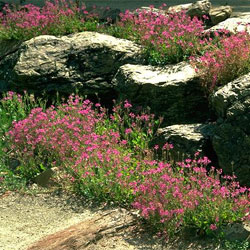Pelargonium rodneyanum
 |
 |
 |
Magenta Storksbill
Pelargonium rodneyanum, commonly known as the Magenta Storksbill, is a member of the family Geraniaceae. Naturally occurring in fragmented populations within heathland, rocky outcrops, sclerophyll forest and woodland areas of South Australia, New South Wales and Victoria. P. rodneyanum is commercially cultivated for use as a colourful potted, rockery or bedding display plant.
 Preferring
well-drained, slightly acidic soil, P. rodneyanum adapts well to most
soil types and likes a full sun to semi-shaded position. It withstands frost
in colder climates, is semi-drought tolerant and is useful as a spreading ground
cover in the garden - easy removal prevents this attractive plant from becoming
invasive. Gardeners also appreciate its lengthy flowering period, producing
blooms when other plants have stopped.
Preferring
well-drained, slightly acidic soil, P. rodneyanum adapts well to most
soil types and likes a full sun to semi-shaded position. It withstands frost
in colder climates, is semi-drought tolerant and is useful as a spreading ground
cover in the garden - easy removal prevents this attractive plant from becoming
invasive. Gardeners also appreciate its lengthy flowering period, producing
blooms when other plants have stopped.
An herbaceous perennial, P. rodneyanum reaches 45 cm in height, flowers during November through to May and forms vertical tubers as part of its root system. The light to dark green leaves are ovate to narrow ovate with crenate, shallow lobes and a 3-10 cm long petiole. The umbel inflorescence usually consists of 7 flowers on slender pedicels 13-22 mm in length, which rise from a whorl of 6 bracts on a 5-12 cm long peduncle. It has five petals that are deep pink in colour and irregular in shape and size. The two larger petals are marked with deep magenta streaks and are positioned slightly separate from the lower petals. Of the ten stamens produced, 7-8 are fertile, slightly longer and bear anthers. The fruit forms on pilose mericarps which, when ripe, each contain a 1.5 mm long, dark grey seed.
P. rodneyanum can be propagated by tuber division (end of winter early spring), soft/semi hardwood cuttings (spring through summer), clump division (all year), meristem culture (all year) and by seed (spring through summer). Using wind as a natural dispersal method, it readily self seeds although new seedlings tend not to flower during the first season of growth.
P. rodneyanum benefits from a hard pruning and reduced water intake during the winter months; tubers may rot if left in water for long periods. During early spring, P. rodneyanum may be susceptible to White Fly, which can be treated with Pyrethrum or diluted dishwashing liquid sprays. Other pests include larger animals (eg. kangaroos and wombats), which during times of drought use the tubers as a food source.
Text by Jacqui McKinnon (2004 Student Botanical Intern)
Derivation of the name: Pelargonium rodneyanumPelargonium - from the Greek word pelargos (a stork) with reference to its storksbill like fruit. rodneyanum - thought to be named after Admiral George Rodney (1718-1792) who lead victorious English naval battles against Dutch, French and Spanish forces. |
References
Elliot, W.R. & D.L. Jones (1997) Encyclopedia of Australian plants: suitable for cultivation, Lothian.
![An Australian Government Initiative [logo]](/images/austgovt_brown_90px.gif)

